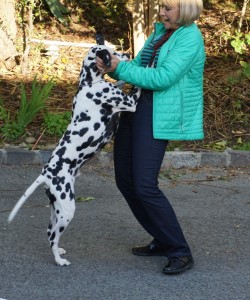All of us have daily challenges, and sometimes tackling them can be demoralizing. We try so hard, whether it is in climbing out of bed to face a routine that bores us, or in trekking off every day to a demanding job. Or maybe it’s in maintaining our patience with our whiny or needy children—whom we love nevertheless. How about empathizing with a spouse over what seems to us to be a minor problem, because we have something major preoccupying us instead?
For the last two years, I have been struggling to help my five-year-old Dalmatian, Cody, to earn his next obedience title, which—as I’ve shared with you here before—is an extracurricular project that lies close to my heart. To bring you up to speed, obedience is a series of performance classes in which the dog and handler work as a team. At our level, Cody and I must execute a series of difficult exercises in sync with each other, all without a leash, following the judge’s commands. (You can learn more about that from the list below.)
Cody has always loved to “work,” ears flipping forward and tail wagging in circles at the mere mention of the word or at the appearance of his dumbbell. His enthusiasm for all of life is one of his characteristics I cherish the most, and it’s no surprise that a bond developed between us over the past four years because of the special time spent together as we train every day.
He began this competitive sport with a bang, moving quickly through the first three levels to capture the blue ribbon in all his classes, as well as twice receiving scores high enough to take the entire obedience trial—a much-respected accomplishment. We practiced hard, but little by little I began to take his aptitude for granted. Perhaps I even grew smug. I simply expected to win.
And then, without warning, Cody’s performances began to deteriorate, slowly but inexorably. We chased our fourth title over many months, but did not succeed, despite our happy daily sessions at home, where working has always been well-interspersed with play. Increasingly less focused while at a trial, he became scattered and unpredictable—more interested in stopping to investigate what was going on outside the ring ropes than to pay attention to me.
During one class, he even took off, galloping down the aisle to greet a total stranger with enthusiasm. This out-of-control behavior was humiliating, (though humorous to those watching), and when I finally caught him, I bowed my head, suppressing tears.
Though I never scolded him, he seemed depressed for weeks afterward, as if he understood that he had disappointed me. From that point on, my nerves played an insistent melody every time we tried again. My anxiety undoubtedly ran right down the leash to his collar, surely making him apprehensive as well. Over and over, I tried to calm myself. And over and over, I failed.
Two long years went by and still the title eluded us. I lost my smile and Cody lost his passion. We were stuck and I was frustrated enough to consider retiring him.
This past February, just when I thought it was time to give up, Cody finally became a “Companion Dog Excellent,” or CDX, once again winning his class. As I drove home that day with the blue ribbon dangling from my rearview mirror, I wondered what had changed for us as a result of our struggle.

Perhaps we were both waiting for the other to grow up a bit. Perhaps I finally gave Cody the support and affection he needed to make working in the ring fun again, and stopped putting such emphasis on performance alone. I overcame my pride and “the butterflies,” and began instead to reward him with hugs, kisses and lots of appreciative thumps on the shoulder, just as if we were simply training at home.
The joy of our teamwork has become visible once again to those watching us from the sidelines. To stay focused on the prize took diligence and determination and patience, not only from me—but from him as well. After all, perseverance is the name of the game, right? Without it, you cannot propel yourself forward enough to accomplish much in any aspect of your life.

Above, I’ve included a video of the five minute run during which Cody earns his CDX. He brought home a very nice score of 194 out of a perfect 200. Two points were deducted for the handler error I made (!), so one might say Cody actually scored a 196. What do I really care about most when I watch it? How happy my boy looks with his tail wagging so hard.
Cody is my star, and, really, he always has been, despite his “wild child” antics in the ring. I’m glad I stuck by his side, and even more than that I’m grateful for everything this experience has brought us—all of which extends far beyond any title. May you find the perseverance to face whatever challenge pushes you to the limit and be blessed by the rewards that follow.
Yours,

Obedience Exercises Required To Become a CDX:
- Heel free: Dog and handler execute a “heeling” pattern around the ring, with no leash connecting them; the dog trots eagerly at the hander’s left side, as the judge calls out a series of commands, (forward, fast, slow, normal, about turn, left turn, right turn, halt), to which the team responds in sync.
- Figure Eight: Dog and handler move in a figure eight heeling pattern around two people acting as marker “posts;” also accomplished without a leash.
- Recall: At the judge’s three commands, the handler first signals the dog to come, then asks for a rapid drop to the floor, and finally calls the dog to sit in front; the dog finishes by moving to sit by the handler’s left leg in heel position.
- Retrieve on the flat: The dog retrieves the dumbbell, which is thrown the length of the ring, then returns with it and sits in front of the handler to release it; dog finishes by sitting at the handler’s left leg in heel position.
- Retrieve over the high jump: The dog retrieves a dumbbell over a jump as high as his shoulder at the withers (for Cody this is 22”); dog then returns over the jump carrying the dumbbell, sits in front to release it and finishes in heel position.
- Broad jump: The dog jumps three boards set up on the floor, spaced to twice the height of his withers. (Cody is 22”, so he jumps 44”.) Handler leaves dog and stands to the right of the jump. While the dog is in the air, handler swivels to face the judge; the dog lands and changes direction to come sit in front of handler, and then finishes in heel position.
- Sits and Downs: For the first exercise, the dog sits. For the second, he lies down. In both he must remain in position, without moving, sniffing or whining, while the handler leaves the ring and goes out of sight, for a total of three and five minutes, respectively. (This exercise is not shown on the video.)
Have a comment or feedback? Talk to Linda!

